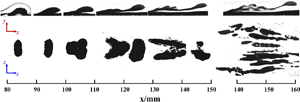Crossref Citations
This article has been cited by the following publications. This list is generated based on data provided by
Crossref.
Liu, Ling
Li, Jing
and
Liao, Shijun
2022.
Explicit series solutions for supersonic flat-plate boundary layer flows.
Physics of Fluids,
Vol. 34,
Issue. 7,
Kong, Yakang
Li, Jun
Wu, Yun
Liang, Hua
Guo, Shanguang
and
Yang, Hesen
2022.
Experimental study on shock‐shock interaction over double wedge controlled by surface arc plasma array.
Contributions to Plasma Physics,
Vol. 62,
Issue. 9,
Yang, Hesen
Zong, Haohua
Liang, Hua
Wu, Yun
Zhang, Chuanbiao
Kong, Yakang
and
Li, Yinghong
2022.
Swept shock wave/boundary layer interaction control based on surface arc plasma.
Physics of Fluids,
Vol. 34,
Issue. 8,
Yang, He-sen
Liang, Hua
Guo, Shan-guang
Tang, Meng-xiao
Zhang, Chuan-biao
Wu, Yun
and
Li, Ying-hong
2022.
Research Progress of hypersonic boundary layer transition control experiments.
Advances in Aerodynamics,
Vol. 4,
Issue. 1,
Kong, Yakang
Wu, Yun
Zong, Haohua
and
Guo, Shanguang
2022.
Supersonic cavity shear layer control using spanwise pulsed spark discharge array.
Physics of Fluids,
Vol. 34,
Issue. 5,
YANG, Hesen
LIANG, Hua
GUO, Shanguang
LUO, Yanhao
TANG, Mengxiao
ZHANG, Chuanbiao
WU, Yun
and
LI, Yinghong
2022.
Experimental study on surface arc plasma actuation-based hypersonic boundary layer transition flow control.
Plasma Science and Technology,
Vol. 24,
Issue. 9,
p.
095503.
Li, Xin
Zhang, Yue
Yu, Hang
Lin, Zheng-Kang
Tan, Hui-Jun
and
Sun, Shu
2022.
Görtler vortices behavior and prediction in dual-incident shock-wave/turbulent-boundary-layer interactions.
Physics of Fluids,
Vol. 34,
Issue. 10,
Verma, Shashi Bhushan
and
Manisankar, C.
2022.
Separation and flow unsteadiness control in a compression corner induced interaction using mechanical vortex generators: Effects of vane size and inter-device spacing.
Physics of Fluids,
Vol. 34,
Issue. 9,
Zhang, Weilin
Ding, Baozheng
Shi, Zhiwei
Shu, Yanlin
and
Sun, Fengtao
2023.
Investigation of drag reduction mechanism for blunt bodies with plasma spikes.
Physics of Fluids,
Vol. 35,
Issue. 8,
Wang, Hongyu
Min, Fu
Xie, Zhendong
Xie, Feng
Li, Jie
and
Yang, Yanguang
2023.
High-speed aerodynamics control using energy injection of pulsed discharges.
Aerospace Science and Technology,
Vol. 133,
Issue. ,
p.
108115.
Smith, Robert D.
Khobragade, Nikhil
Sasidharan, Unnikrishnan
and
Kumar, Rajan
2023.
Effect of Incoming Boundary Layer Thickness on the Flow Characteristics of a Supersonic Air Intake.
2023.
Plate boundary layer transition regulation based on plasma actuation array at Mach 6.
Physics of Fluids,
Vol. 35,
Issue. 6,
Xie, Wei
Luo, Zhenbing
Zhou, Yan
Cheng, Pan
Liu, Qiang
Peng, Wenqiang
and
Deng, Xiong
2024.
Influence of volume and frequency parameters on opposing plasma synthetic jet for drag reduction in supersonic flow.
Aerospace Science and Technology,
Vol. 146,
Issue. ,
p.
108971.
Zong, Haohua
Wu, Yun
Liang, Hua
Su, Zhi
and
Li, Jinping
2024.
Experimental study on Q-learning control of airfoil trailing-edge flow separation using plasma synthetic jets.
Physics of Fluids,
Vol. 36,
Issue. 1,

 $\varLambda$ vortex and evolution of the hairpin vortex.
$\varLambda$ vortex and evolution of the hairpin vortex.




